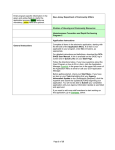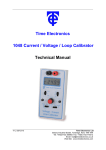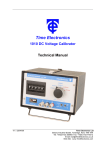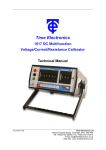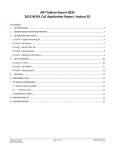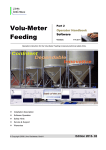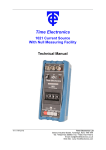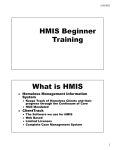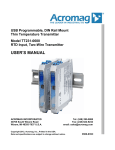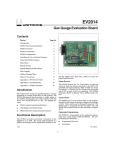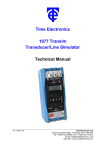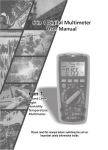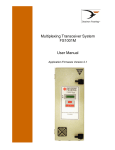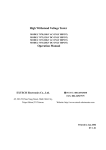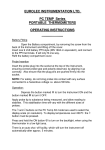Download 1024 User Manual - Time Electronics
Transcript
Time Electronics 1024 DC Current Calibrator With Null Measuring Facility Technical Manual V1.1 20/04/09 Time Electronics Ltd Botany Industrial Estate, Tonbridge, Kent, TN9 1RH Tel: +44(0)1732 355993 Fax: +44(0)1732 770312 Email: [email protected] Web Site: www.TimeElectronics.com 2 C ontents 1. 2. Introduction ............................................................................................................ 3 1.1. General Description................................................................................................ 3 1.2. Specifications ......................................................................................................... 4 Operation ................................................................................................................ 5 2.1. Front Panel Controls .............................................................................................. 5 2.2. Operating Procedures and Precautions ................................................................ 7 2.2.1. 2.2.2. 2.3. 2.4. Output Noise ........................................................................................................... 7 Mains Power Unit .................................................................................................... 9 2.4.1. 2.4.2. 2.4.3. 3. Chopper amplifier module ....................................................................................10 3.1.1. 3.1.2. Description .................................................................................................................. 10 Module replacement ................................................................................................... 10 Recalibration ........................................................................................................ 11 4.1. Repairs ...................................................................................................................11 4.2. Recalibration ..........................................................................................................11 4.2.1. 4.2.2. 5. Type PU2 ...................................................................................................................... 9 Constructional details PU2 ........................................................................................... 9 240V to 110V conversion ............................................................................................. 9 Constructional Layout Details ............................................................................ 10 3.1. 4. Normal Operation ......................................................................................................... 7 Overload conditions ...................................................................................................... 7 Calibration Procedure ................................................................................................. 12 Linearity ...................................................................................................................... 12 Guarantee & Servicing......................................................................................... 13 All Time Electronics' instruments are subject to continuous development and improvement and in consequence may incorporate minor detail changes from the information contained herein. 1024 Technical Manual 2 3 1. Introduction 1.1. Description • Up to 100mA output • 0.02% accuracy • 10 ppm/hr stability • Null facility • Portable • Battery & mains operation The 1024 is a solid state battery powered instrument which is easily portable and convenient for laboratory, field, or industrial use. It incorporates many of the well-proven circuit techniques of the Time Electronics Type 1010 DC Voltage Calibrator. The null balance system enables the 1024 to be used for making accurate current measurement in addition to its basic function as a calibrator. Operation is by backing the current source output against the current to be measured, with the difference being displayed on a sensitive centre zone null meter. At the null point, there is no voltage drop across the 1024. The 1024 employs a precision aged reference diode as a basic reference source. Excellent zero stability is ensured by the use of a high performance FET chopper amplifier system. Precision metal film resistors with temperature co-efficients of less than 10 ppm per ºC are used to maintain the accuracy and stability of the initial calibration. Operation is from battery or mains. A front panel indicator that also serves as a supply on-off display monitors the battery supply condition. A minimum line on the indicator shows when the batteries should be recharged. Charging is performed by its own internal charger/power supply. Simply plugging the 1024 into a mains supply will charge the batteries. Operation of the 1024 may be continued when plugged into the mains. Applications include calibration and testing of current sensitive transducers; calibration and linearity tests on digital and electronic current meters; and semiconductor parameter measurements e.g. diode conduction voltages at specified current levels. 1024 Technical Manual 3 4 1.2. Specifications Output: 0-100mA in 5 ranges 0-99.999mA in 1uA steps 0-9.9999mA in 100uA steps 0-999.99uA in 10nA steps 0-99.999uA in 1nA steps 0-9.9999uA in 0.1nA steps Accuracy: +/- 0.02% of setting, +/- 0.005% of range, +/- 0.2nA Voltage Capability: 15V with new batteries or mains power (11V with minimum allowable battery level) Regulation: Load: Better than 5ppm per Volt Supply: Better than 5ppm per Volt Output polarity: Positive or negative switch selected. A centre off position provides an open circuit on the output terminals Out of limit warning: A front panel indicator provides a warning of insufficient drive voltage Output stability: Less than 30 ppm per °C (0°C to + 50°C) Less than 10 ppm per hour at constant temperature Less than 75 ppm per 6 months Output noise: 100, 10 and 1mA ranges: less than 5ppm of full scale 100 and 10uA ranges: less than 10 ppm of full scale +/- 0.1nA Null sensitivity: Adjustable from +/- 25 mA to +/- 25uA FSD via front panel control. Maximum resolution is 0.5uA. Power supply: Time Electronics power unit type PU2 which is housed in the rear of the 1024. The PU2 will power the 1024 direct from the mains or an internal rechargeable battery. The battery is automatically charged when mains power is connected. Dimensions: L 220mm x H 160mm x D 200mm Weight: 3.3 Kg 1024 Technical Manual 4 5 2. Operation Despite being a precision instrument the 1024 does not require special operating conditions or procedures. Its robust construction and stable solid state circuitry enables it to be used in nearly all applications with only the normal operating precautions. k i f g j h e b a d c 2.1. Front Panel Controls a) Output terminals The 1024 output current is from two front panel terminals which are suitable for wire compression or 4mm plug insertion. The output current will flow from the + (red) terminal when the polarity switch is ‘normal’. b) Case terminal The case terminal is connected only to the instrument case and is isolated from the circuitry. The case provides an overall electrostatic screen for the 1024 and can be earthed as required to improve rejection of noise pick-up. c) Supply ON-OFF A miniature toggle switch interrupts the supply line to the circuitry. Indication of supply ‘on’ or ‘off’ condition is provided by the battery level indicator. d) Output Polarity A change-over toggle switch enables the output current polarity to be reversed. A centre ‘off’ position provides an open circuit on the output terminals. 1024 Technical Manual 5 6 e) Battery Level The battery (or mains power supply PU2) output is continuously monitored on a front panel indicator which also serves as a supply ‘on-off’ indication. A minimum mark indicates when the batteries need recharging. f) Range One of the five output ranges can be selected. g) Digit Switches A 5-decade thumbwheel switch enables the output current level to be set with a resolution of 0.01% of full scale. h) Voltage Limit An L.E.D. indicator shows when the 1024 is unable to supply sufficient drive voltage to maintain the set output current. Example: The 1024’s maximum drive voltage (voltage capability) is 15 Volts. This means that it is able to supply a current of 1mA into 15K ohms but NOT 1mA into 16K ohms. In the latter condition the voltage limit indicator would display. The above is an example and applies similarly for any product of current and load resistance that exceeds 15 volts. Non-resistive loads are still bound by the same output voltage limit with the indicator displaying when the voltage at the output terminals reaches about 15V. Note: When the 1024 is operated from partly discharged batteries, the voltage limit is reduced to a minimum of about 10V for nearly fully exhausted cells. The battery level indicator gives a clear indication of battery state. i) Null Meter Scaled 0 to 25 for displaying the difference current when the 1024 is used in the null mode. j) Sensitivity Control A continuously variable control for adjusting the null meter sensitivity, range of adjustment is from 25mA minimum (fully anticlockwise) to 25uA maximum (fully clockwise). k) Source - Null Switch A two position toggle switch which selects the mode of operation. In the SOURCE position the 1024 operates as a current source while the null position allows measurement of current. Important Note: Under no circumstances must an additional voltage be connected in series with the 1024 output in an attempt to increase the voltage capability. This practice will cause damage to this 1024’s output circuitry. Under certain conditions the voltage capability can be increased to a maximum of 50volts. This requires special circuit modifications and is only applicable to certain ranges. Please consult Time Electronics (or their authorised dealer) for information. 1024 Technical Manual 6 7 2.2. Operating Procedures and Precautions 2.2.1. Normal Operation Operation of the 1024 is self-explanatory from the front panel controls and specifications. It is important to understand the 1024’s voltage capability and voltage limit indicator to ensure that your requirement is within the limit. It is also important to read section the section on output noise if your requirement is for current levels of less than a few tens of microamps. When the 1024 is operating from batteries and required to supply currents in excess 10 10mA it is important to check the battery condition with the load connected since the battery’s condition may be adequate for small output currents but not large ones. Measurement of an unknown current: 1) Select ‘NULL’ position on the front panel function switch. 2) Select ‘NORMAL' output. 3) Adjust ‘SENS’ for minimum sensitivity (fully anticlockwise). 4) Select range consistent with current to be measured. 5) Connect the unknown current to the terminals in the same polarity i.e. unknown current flows into the + Ve terminal. 6) Adjust digit switch and sensitivity control for null balance on meter as required. 7) When balance at required sensitivity is reached the unknown current is equal to the digit switch setting. 2.2.2. Overload conditions The 1024 can withstand indefinitely either short or open circuit on the output terminals. Overload conditions can easily result if any attempt is made to drive current into the 1024 by applying a voltage to the output terminals. In most cases this will cause the output fuse (See Section 2.5) to blow but can still cause damage to the output circuitry. 2.3. Output Noise a) Inherent Noise The electrical noise on the output current consists of chopper intermodulation, thermal noise and random variations. These are generated inside the 1024 and originate from the active circuitry. At current levels of greater than about 1mA the noise fluctuations are those of the accurate voltage reference circuitry. At currents below a few hundred microamps it becomes difficult to differentiate between the 1024 inherent noise and picked-up noise (see Section 2.3b) b) Noise Pick-up In addition to the inherent noise from the 1024 circuitry the output can contain fluctuations which originate from outside sources. As with voltage signals the effects of noise on current signals are usually measured as a fraction of the signal (in % or PPM) and in general this fraction becomes larger as the signal level is reduced. A good deal of care must be taken in attempting to understand the cause an effect of noise pick-up on precision current sources such as the 1024 and it is not proposed that this manual should cover them in detail. 1024 Technical Manual 7 8 It is important when confronted with a problem of noise pick-up to stop and think logically about the cause and effect - a good deal of time can be wasted by indiscriminate screening and earthing! This is particularly important when dealing with current signals since many of the effects are the exact opposite from those for voltage signals e.g. earthing one side of a voltage signal may reduce the noise pick-up but earthing the same side of a current signal may increase the pick-up. Before looking at possible sources of noise pick-up it is also important to consider the way in which the presence of noise is being detected. In many cases it will appear as an incorrect readout. Special care must be taken if additional equipment (such as an oscilloscope of DVM) is connected for the detection of noise - there is a possibility that this can introduce further noise. Two of the more common causes of noise pick-up are discussed below. The actual level of pick-up cannot be predicted and will depend on a number of factors. (1) 50-60 Hz Mains Supply: This is probably the largest single source of noise pick-up. The noise from this source can be divided roughly into two parts. a) 50-60 Hz Signal pick-up - is generally caused by the close proximity of unscreened mains cables or mains powered equipment. The effects of this type of noise can usually be considerably reduced by correct screening and earthing. Important Note: When the 1024 is operated from the mains, special attention should be paid to the possibility of noise pick-up occurring. Battery operation is recommended for applications requiring the lowest noise pick-up condition. b) Transient Signal pick-up - is generally caused by heavy load switching on the mains from equipment such as electric motors, electric ovens, etc. Its effect on the 1024 is to cause a transient variation in the output which can last longer than the actual duration of the noise. This is because the 1024 has been transiently overloaded and needs time to recover. The noise is often in the form of a burst of radio frequency energy which in addition to being carried in mains cables is also radiated into the atmosphere. It is often difficult to detect its presence due to its transient nature and short duration (down to a few 10's of microseconds). The effects of this sort of noise on radio and television reception are well known and a transistor radio is often a useful tool in locating the source of the noise. This type of noise often covers a very wide spectrum of frequencies and the most effective solution is to locate its source and provide suitable filtering - such as conventional capacitor suppression on arcing contacts. (2) Common Mode Noise: Additional noise and variation of the output current can be caused by large common mode voltages. These occur when the 1024 is used to calibrate any input which is above ground potential or has an a.c. component with respect to ground. When powered by the internal battery the 1024 has inherently a very high d.c. common mode rejection, but it is not recommended under normal circumstances that 100V d.c. common mode be exceeded. The a.c. common mode rejection is determined by the capacitive unbalance to ground of the output terminals and associated connections. 1024 Technical Manual 8 9 2.4. Mains Power Unit 2.4.1. Type PU2 The PU2 incorporates a rechargeable Nickel-Cadmium battery and electronics charge control circuitry. The circuitry is arranged to enable the PU2 to provide power directly from the mains if the mains input is connected or alternatively from the rechargeable battery if mains is not connected. When the mains is connected the charging circuitry provides the correct charge current (4045mA) for the battery and automatically reduces this to a trickle rate (3 - 4mA) when the battery is fully charged. This means that it is impossible to overcharge the battery. The DC performance is as follows: With mains connected: DC output 15.5 - 7V (0 - 100mA load). With mains disconnected (and battery fully charged): DC 14.5 - 15.5V (0 - 100mA load) Mains input range: 110 - 250V AC 40 - 60 Hz. IEC mains input fuse is 20mm F1A. The capacity of the rechargeable battery is approximately 450mA Hrs. This allows about 40 - 50 hrs continuous use of the 1010. To fully recharge the battery requires 14-16 hours with mains connected. 2.4.2. Constructional details PU2 The P.C.B. is located on the rear panel by 4 screws and is spaced off approx. 10mm. A metal cover protects and screens the P.C.B. and components. The output connectors and output fuse are located outside the cover. The cover is fixed to the rear panel by a 4 screws. Later versions of PU2 have a 20mm F500mA fuse located inside cover. Important Note: Take care when checking and dismantling a PU2. Even though disconnected from the mains, there is still sufficient power stored in the rechargeable battery to cause catastrophic damage to the electronic circuitry if inadvertent short circuits occur. These can easily occur when the metal cover is being removed. 2.4.3. 240V to 110V conversion The PU2 mains transformer has tappings for 240V or 110V AC mains. The following procedure should be adopted to convert from 240V to 110V. 1) Remove mains power unit from 1010. 2) Remove P.C.B. metal screening cover. Note: Take care not to short any part of the circuitry when converting a PU2. 3) Connect mains transformer windings in parallel by rewiring the mains input to the transformer (As shown on the side of the transformer). 4) Replace the screening cover. 1024 Technical Manual 9 10 3. Constructional Layout Details The complete instrument assembly (except the Power Unit) is mounted on the front panel. A printed circuit board which carries the components and range switch is located immediately behind the front panel. The panel and p.c.b. can be removed as follows: 1) Remove Power Unit - located in instrument rear by 4 screws. 2) Disconnect supply - connected to power unit by 2 press stud connectors. 3) Remove front panel locating screws. 4) Withdraw front panel and p.c.b. - the power supply lead can also be withdrawn through a hole in the plastic power supply cover. For recalibration the power supply can be connected without rehousing in the case. 3.1. Chopper amplifier module 3.1.1. Description The module contains the F.E.T. Chopper amplifier, precision zener and associated circuitry. It is a fully encapsulated module and connections are via a 16 pin connector moulded into it. The modular form of the 1010’s basic circuitry protects it from damage due to adverse conditions and thermal gradients which could give rise to thermal emf errors. A replacement procedure should be adopted in the case of failure or malfunctioning of the module - see Section 3.1.2. 3.1.2. Module replacement 1) Remove and disconnect power unit located in instrument rear by 4 screws. 2) Remove front locating screws. 3) Carefully withdraw the front panel and associated printed circuit board (p.c.b.). The power supply lead can also be withdrawn through a hole in the plastic supply cover. 4) Remove 4 nuts which locate the module on the p.c.b. 5) Withdraw the module from the p.c.b. 6) Remove 4 nuts remaining on module mounting studs. Put these nuts on the new module. Replace new module in reverse order ensuring the connector pins align correctly - it may be necessary to bend slightly the mounting studs in order to obtain smooth alignment of the 16 pin plug and socket. Note: It is important not to overstress the plug and socket, since poor connection will result. 7) Adjust the position of the module above the p.c.b. with 6 nuts on the module side of the p.c.b. When the module is parallel the plug and socket just closed, the nuts on the opposite side of the p.c.b. can be tightened. It is important to ensure that no strain is put on the connector when the nuts are finally tightened. 8) Set Module zero and recalibrate as described on the following page. 1024 Technical Manual 10 11 4. Recalibration 4.1. Repairs Access to the circuitry is by removing the front panel which is located by 4 screws. Two preset trimmers are provided. One provides adjustment of the zero and the other full scale. If readjustment is necessary the output should be set up against suitable standards. Due to the precision nature of many of the components used in the 1024, they are not readily available to enable the customer to undertake repairs. Repairs to the power unit (Section 2.4) and the front panel components can be undertaken by the customer provided suitable tools are available. Spare parts can be obtained from Time Electronics or their authorised dealer. Important Note It is important that no repair work is undertaken by the customer while the 1024 is under warranty. Such work may invalidate the warranty. Overload conditions can cause the fuses to blow and the following conditions will be observed:(1) The instrument is inoperative, the battery level indicator does not operate when the 1024 is switched on. Possible causes are: a) Main fuse blown (on PU2 power unit). b) PU2 output fuse blown. c) Front panel P.C.B. supply fuse blown. (2) The battery level indicator displays but no output appears at the output terminals. Possible cause is: a) Front panel P.C.B. output fuse F1 blown. 4.2. Recalibration The 1024 is calibrated when it leaves the factory and should not require further adjustment for at least 12 months unless the circuit module or any of the calibration determining components have been changed. It is important before considering recalibration to ensure that an apparent error in output current is not due to inadequate measuring equipment or noise pick-up. (See Section 2.3). The latter is a common cause of trouble at low settings of output current particularly when mains power is being used. It is also important to ensure that the correct equipment is available before attempting recalibration. There are two ways in which the 1024’s output can be checked accurately – these are: a) By a current balancing method using an external Standard D.C. Current Source of known accuracy and a nanometer with ranges from +/- 1nA to +/- 100uA. It is then possible to display the difference between the 1024 output and the standard current source. 1024 Technical Manual 11 12 b) The 1024’s output can be converted to voltage by using precision resistors on the 1024 output. High performance resistors are required with accuracies of better than 0.01%, 1ohm, 10 ohms, 100 ohms, 1K ohm and 10K ohms are usually adequate. The low values must have excellent stability at currents up to 100mA if errors are not to be introduced due to the temperature rise in the resistor under load. Power dissipation is 1 watt in the 10 ohm at 100 mA. The voltage across the precision resistors can be measured by normal voltage measuring techniques provided adequate precautions against noise pick-up are taken, these are more likely to occur with the higher resistor values. Method a) is to be preferred since the problems of noise pick-up, conversion and dissipation errors, and thermal emf’s are much less. It is also recommended that the 1024 be operated in its battery powered mode for all calibration procedures. This is to reduce the possibility of noise pick-up which can give erroneous results. A total of 8 multiturn trimmers are provided, 3 for zero adjustment and 5 for range full scale calibration. The sequence of adjustment is important since some of the trimmers affect more than one range. The calibration procedure is as follows: Ensure the internal battery pack is fully recharged. Remove the front panel and locate the 7 trimmers, VR1-VR5 are located on the front panel P.C.B. The other 2 trimmers are located on the side of the encapsulated circuit block and marked ‘CAL’ and ‘ZERO’. Switch on the 1024 and allow the circuits to stabilise for a few minutes. Ensure that no draughts or direct heating (e.g. sunlight) affect the 1024’s circuitry. Calibrate at a stable temperature of between 20-24 °C if possible. 4.2.1. Calibration Procedure For serial numbers 1218K6 and later. 1) Set the digit switch to zero and select 100uA range. Adjust output to zero (+/- 0.5uA) with ‘ZERO TRIMMER’ on module. 2) Select 10uA range and adjust output to zero (+/- 0.3nA) with VR1. 3) Set digit switch to 99999 and select 100uA range. Adjust output to 100uA +/- 5nA with ‘CAL TRIMMER’ on module. 4) Select 10uA range and set output to 10uA +/- 1nA with VR2. 5) Select 1mA range and set output to 1mA +/- 50nA with VR5. 6) Select 10mA range and set output to 10mA +/- 500nA with VR4. 7) Select 100mA range and set output to 100mA +/- 5uA with VR3. Note: If method (b) is being used for calibration 7) above, a highly stable 10 ohm resistor is required since 1 watt is dissipated in the resistor. A 1 ohm may be used as an alternative if a suitable 10 ohm is not available. 0.1 watt will be dissipated in a 1 ohm resistor. 4.2.2. Linearity The linearity of the output is not adjustable and is determined by the precision resistors mounted on the digit switch. These have been selected and adjusted in the factory and should not require further alteration. 1024 Technical Manual 12 13 5. Guarantee & Servicing Guarantee Period This unit is guaranteed against defects in materials and workmanship for a period of one year from its delivery to the customer. We maintain comprehensive after sales facilities and the unit can, if necessary be returned to us for servicing. During this period, Time Electronics Ltd will, at its discretion, repair or replace the defective items. For servicing under guarantee, the instrument type and serial number must always be quoted, together with details of any fault and the service required. The purchaser of the instrument must prepay all shipping charges. Time Electronics Ltd will pay return shipping charges. This guarantee is void if servicing has been attempted by an unauthorised person or agent. If, during the guarantee period, failure is due to misuse or abuse of the unit, the repair will be put in hand without delay and charged unless other instructions are received. Please note that if you require a new UKAS Certificate during the warranty period, this will be charged at the current rate on our price list. Service After Guarantee Period Even after the guarantee period has expired, Time Electronics Ltd., can still service your instrument. As the manufacturer, we have the specialised knowledge needed to keep your instrument in peak condition and we also maintain a comprehensive spare parts service. Please enclose details of the service required and your full company details including a contact name when returning for servicing. Returning Instruments When returning instruments, please ensure that they have been adequately packed, preferably in the original packing supplied. Time Electronics Ltd will not accept responsibility for units returned damaged. Please ensure that all units have details of the service required and all relevant paperwork. Send the instrument, shipping charges paid to:- Time Electronics Ltd Botany Industrial Estate, Tonbridge, Kent, TN9 1RH Tel: +44(0)1732 355993 Fax: +44(0)1732 770312 Email: [email protected] Web Site: www.TimeElectronics.com Disposal of your old equipment 1. When this crossed-out wheeled bin symbol is attached to a product it means the product is covered by the European Directive 2002/96/EC. 2. All electrical and electronic products should be disposed of separately from the municipal waste stream via designated collection facilities appointed by the government or the local authorities. 3. The correct disposal of your old appliance will help prevent potential negative consequences for the environment and human health. 4. For more detailed information about disposal of your old appliance, please contact your city office, waste disposal service or return to Time Electronics. 1024 Technical Manual 13













